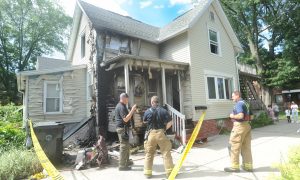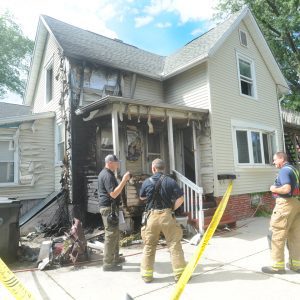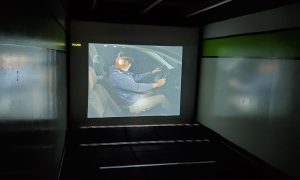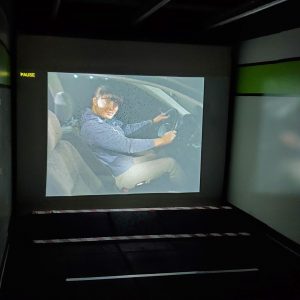WESTFIELD – The city may not see a consolidated public safety complex for several years but city officials are taking steps to consider the possibility of merging the police, fire and perhaps the emergency management departments into a single complex at some future date.
The members of the City Council’s Finance Committee voted unanimously Tuesday evening to recommend that the full council appropriate $33,500 to study the city’s options at the council meeting Thursday evening.
At the meeting, the fully council voted unanimously to appropriate the funds.
Westfield Mayor Daniel M. Knapik said Wednesday morning that a single complex for the city emergency services department was “a priority” for some members of the city council and he agrees that a study would be useful to know what the city’s options are.
“That conversation started literally the moment I walked into office. There were a number of councilors that wanted to go down that road,” he said.
He said that the study will not only determine if it is sensible and feasible to co-locate the emergency services departments but will also find out if there is a suitable site for a joint complex downtown.
“What it comes down to is geography” Knapik said and went on to ask “Is there enough geography in the center part of the city anywhere that we can pull this off?”
He said that the complex should be “in some proximity to the major traffic arteries” and also noted that the condition and capabilities of the current buildings are considerations.
Knapik observed that the apparatus the fire department now uses strains the building which was built to house the technology of the ‘70s and the police station is also crowded by a department that has grown considerably since the building was designed.
“Both facilities are over 40 years old now and then, by the time we actually get in a position to do a project, they’ll be 50 years old,” he said.
Police Chief John Camerota said before the council voted that he would welcome new facilities for his department but wondered if solutions could be found for the twin hurdles of cost and location.
“The problem we’re having here is we’re outgrowing our existing building” which, he said, has had problems since it was built.
With a unified safety complex, Camerota said, “We could even bring dispatch back.” He said “A new facility with a larger dispatch center would be nice” as the city attempts to create a regional dispatch center around the city’s newly combined emergency dispatch center.
But, he said “You’d need a large parcel of land” he said and went on to say “it would be a busy location so we would look for easy access, probably a traffic light (at) a main intersection but those are prime tax properties.”
“Tax dollars are more important” he said. “They’re looking to get tax dollars, they’re not looking to take valuable property to stick a police department on.”
The other problem Camerota spoke of is financial.
“The big issue is funding sources” he said. “If there were some funding sources out there that made sense then maybe it is time to make the move. But there’s just not a lot of money available.
Because of those two issues, Camerota said he doubts if the city will see anything soon.
“I’m not opposed to it,” he said. “Do I think it will happen in my career? No. I know there are other priorities in the city and I’m fine with that. We’ll make do with what we have”
Albert Masciadrelli, the chairman of the Fire Commission, said recently that the concept of a central safety complex was something the commission “did kick around” in the past few years and said that the study would be a necessary first step.
“The whole thing depends on the footprint” of the project and its impact on traffic and the city’s core business district, Masciadrelli said.
He also pointed out that homeland security concerns are playing an increasing part in emergency service planning and suggested that the study might find that centralizing emergency capabilities may not be the best idea.
He said that perhaps the study will find that while administrative functions might be effectively centralized, the fire apparatus might be better dispersed at several locations both to improve response time and to prevent all the city’s emergency responders from being bottled up by a natural disaster or a deliberate act.
Masciadrelli stressed that it is important to keep an open mind about the study and said that such studies usually come up with good recommendations for action.
Knapik said “We’re not ready to build anything yet but certainly within six to eight years from now we ought to be able to have a plan together in case we decide to pull the trigger on it.”
Mary Regan, the city’s fire chief, said “I don’t think it’s going to happen, probably, in my career” and said that she is much more excited about a second study the finance committee also opted to recommend and which was also approved by the council.
That study, at a cost of $11,800, will consider the best course of action to optimize the Little River fire substation.
Regan said that the building is in dire need of repair and renovation and said that study will determine the scope of the work to be done there.
Regan said that some changes, such as renovating the dormitory and bathroom facilities to accommodate both male and female firefighters, are obviously necessary, but additions to the building may also be justified.
She said that, currently, apparatus is moved out of the bay to accommodate classes or other activities and an addition to the building might be worthwhile to make that practice unnecessary.
Another possibility she mentioned would be to house functions currently managed at the headquarters, such as the fire prevention office, at an addition to the substation.
Such a move, Regan said, would not only alleviate crowding at the headquarters but would also keep the substation open when the firefighters there respond to an alarm.








